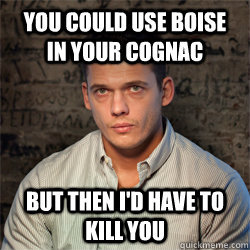France Day 6: To Boisé or not to Boisé

I was never really too clear about Cognac aging, but I knew that there wasn't much new wood involved. They weren't using old Bourbon or old Sherry casks, yet many of the Cognacs we carried had dark, amber colored hues with rich, supple textures. Sweetness in brandy, just like whisky, comes from the barrel, as does the color. Bourbon tastes rich and sweet because it's put directly into new, heavily charred casks immediately after it's distilled where it remains until the day it's bottled. Cognac goes into lightly charred casks for around five to twelve months before it's transfered into an older barrel. New in Cognac terms can mean a barrel that's been used zero to four times - the more often it's been used, the longer the first maturation lasts to make up for the weaker wood influence.
So.....if Cognac producers don't heavily char their casks to release more color and vanilla from the wood, and they don't leave their spirit in the "new" wood for very long, then where the heck is that color coming from? The answer can be multifacted, but there's usually a creeping suspicion in these cases that something else is being added to the brandy. In fact, with Cognac, it's perfectly legal to do so. Besides the addition of caramel coloring to deepen the shade of brown, a substance called boisé is regularly added to intensify color, sweetness, and texture. Boisé is a mixture of sugar, oak chips, and lower-proof brandy that is left to macerate in a barrel or tank. The color is extracted from the oak ships and the boisé acts like a concentrated syrup which can make young Cognac both taste and appear older than it is.
The terms VS, VSOP, and XO are used to help designate maturity on a Cognac bottle, but they're usually quite misleading. VS simply means at least two years old, VSOP means at least four, and XO at least six. However, the producers we're looking to buy from aren't releasing VS Cognacs under ten years old. When tasting at the estates of the distillers, we generally ask which vintages the Cognacs are composed of, say a mix of 1991 with 1994, for example. When a producer tells us a Cognac is comprised of 2004 with 2006 and the color looks like toffee, then we know what's being done to make it look that way. There's a big difference between the flavor in pre-boisé and post-boisé Cognac. David and I have done some extensive cask tasting over the last few days and many of the Cognacs do not taste that great straight from the barrel.
Now, although it may seem like cheating when compared to Bourbon, single malt, and Armagnac, the addition of boisé to one's Cognac doesn't necessarily mean that the brandy isn't good. The most successful Cognacs in the world are loaded with it. However, when it's used in younger Cognacs to add richness that wouldn't normally be there, the result can be quite terrible. The reason producers do it, however, is because aging Grand Champagne Cognac takes FOREVER. Like I stated in previous posts, we tasted some 60+ year old brandies from Dudognon (a producer that NEVER adds boisé) and they were still babies. Using more new oak would destroy the delicate flavor from the high-quality grapes, so that's not an option either. The answer is simply time, something that most producers don't have.
The Cognac market is very strong right now, which is why the price of Grand Champagne fruit is high. Hennessy, Martel, and Remy are buying whatever they can get their hands on (usually very young Cognacs), adding loads of boisé, and pumping them overseas to awaiting night clubs. The marketing departments are out there pushing the quality of the big houses, despite the fact that the quality is terrible compared to some of the smaller producers.
Anyway, it's something to think about. We're obviously trying to go "zero boisé," but we're not going to turn down a fantastic Cognac if there happens to be some in it. One more stop today and then we're on the road north to Normandie.
Until then....
-David Driscoll
